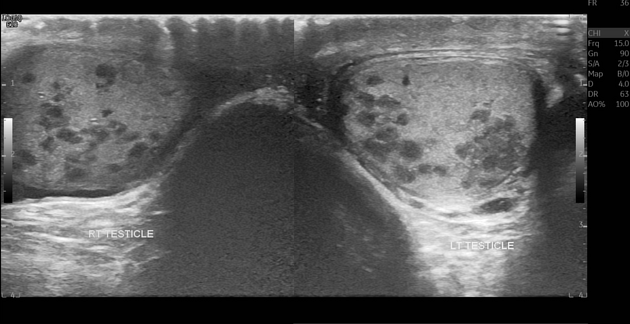Presentation
Presented to the Emergency Department with shortness of breath, dysuria and testicular pain. No significant past medical history.
Patient Data

Bilateral consolidation and cavitary lesions predominantly in the upper lobes with relative sparing of the lower lungs.
Scattered tree in bud opacities in the bilateral lungs with areas of bronchiectasis.
Scattered calcified mediastinal lymph nodes and granulomas in the bilateral lungs.

Heterogeneously mildly enlarged epididymis and testicles bilaterally with scattered hypoechoic nodular lesions.
Left complex multiseptated hydrocele.
No significant increase in vascularity.
Case Discussion
This patient presented to the Emergency Department with dysuria and shortness of breath. Initial chest x-ray had findings concerning for tuberculosis which was followed up by chest CT. Following confirmation of diagnosis, a scrotal ultrasound was performed given the patient's dysuria.
Ultrasound showed findings consistent with tuberculous orchitis, including bilaterally enlarged epididymis with scattered hypoechoic nodular lesions. A biopsy has been discussed with the patient, but he has declined. This patient has been in the hospital for 3 weeks following diagnosis and is currently treated with rifampin, isoniazid, pyrazinamide and ethambutol (RIPE therapy) + 1 week of carbapenem.
Tuberculous orchitis is a rare complication that occurs in roughly 3% of cases. The current mainstay of treatment of urogenital tuberculosis is RIPE therapy, while patients who are refractory to RIPE treatment or are presenting with complications should undergo surgery. One issue that might arise during treatment is intolerance of medical therapy.
Acknowledgements: Case reviewed by and written in conjunction with resident physician Edwin Wang, M.D.




 Unable to process the form. Check for errors and try again.
Unable to process the form. Check for errors and try again.